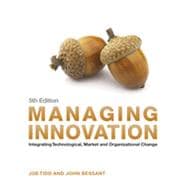Managing Innovation is an established, bestselling text for MBA, MSc and advanced undergraduate courses on innovation management, management of technology, new product development and entrepreneurship. It is also widely used by managers in both the services and manufacturing sectors.
Now in its fifth edition, Managing Innovation has been fully revised and now comes with a fully interactive e-book housing an impressive array of videos, cases, exercises and tools to bring innovation to life. The book is also accompanied by the Innovation Portal at www.innovation-portal.info, which contains an extensive collection of additional digital resources for both lecturers and students.
Features:
- The Research Notes and Views from the Front Line feature boxes strengthen the evidence-based and practical approach making this a must read for anyone studying or working within innovation
- The Innovation Portal www.innovation-portal.info is an essential resource for both student and lecturer and includes the Innovation Toolkit – a fully searchable array of practical innovation tools along with a compendium of cases, exercises, tools and videos
- The interactive e-book that accompanies the text provides enriched content to deepen the readers understanding of innovation concepts








